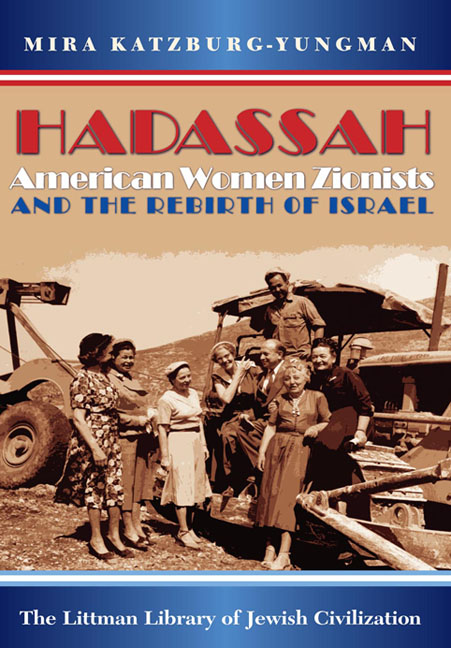Book contents
- Frontmatter
- Dedication
- Preface and Acknowledgements
- Contents
- List of Plates
- Note on Transliteration
- Prologue
- PART I CONTEXTS AND CHALLENGES
- PART II THE AMERICAN SCENE: IDEOLOGY AND PRACTICE
- PART III THE WORLD ZIONIST ORGANIZATION SCENE
- PART IV THE ISRAELI SCENE: HADASSAH AND THE NEW STATE
- PART V HADASSAH IN CONTEXT
- 12 Comparative and Feminist Perspectives
- 13 Hadassah's Partners
- Epilogue
- APPENDICES
- Bibliography
- Plate Acknowledgements
- Index
12 - Comparative and Feminist Perspectives
from PART V - HADASSAH IN CONTEXT
- Frontmatter
- Dedication
- Preface and Acknowledgements
- Contents
- List of Plates
- Note on Transliteration
- Prologue
- PART I CONTEXTS AND CHALLENGES
- PART II THE AMERICAN SCENE: IDEOLOGY AND PRACTICE
- PART III THE WORLD ZIONIST ORGANIZATION SCENE
- PART IV THE ISRAELI SCENE: HADASSAH AND THE NEW STATE
- PART V HADASSAH IN CONTEXT
- 12 Comparative and Feminist Perspectives
- 13 Hadassah's Partners
- Epilogue
- APPENDICES
- Bibliography
- Plate Acknowledgements
- Index
Summary
OUR UNDERSTANDING of Hadassah and its sources of strength can be enriched by comparing it to other American Zionist organizations, in particular the Zionist Organization of America (ZOA), Pioneer Women, and the Mizrachi Women's Organization of America, and also with WIZO, the Women's International Zionist Organization.
HADASSAH AND THE ZIONIST ORGANIZATION OF AMERICA
The ZOA led the American Zionist movement's struggle for the establishment of the State of Israel. Its contribution to this cause, in the political and public campaigns alike, was tremendous; however, after independence was achieved, the ZOA lost both its political leverage and its popular support while Hadassah continued to thrive. The reasons for this development and the conclusions that may be drawn from it are relevant not only to the study of the period immediately after Israel's independence but also to a broader understanding of the two leading American Zionist organizations, and of American Zionism as a whole.
THE ZOA'S SEARCH FOR A NEW PURPOSE
From late 1948 the ZOA was in a state of deep crisis, evident in two major phenomena: first, a steep decline in membership, which by 1953 had dwindled from its 1948 level of 225,000 to 95,000; and second, in its search for significant new fields of activity. The most likely cause of both was that with the creation of a Jewish state, its main purpose—the political efforts to assure that objective—had ceased to exist.
Many of the ZOA's members were businessmen, who were very much engrossed in their private enterprises. It takes a great challenge to draw such timepressed people into public affairs. The three years preceding the foundation of the State of Israel provided just such a challenge, unparalleled in the history of Zionism, perhaps in all of Jewish history. However, after the establishment of Israel— and despite the new state's need for massive political and financial support—the ZOA lacked objectives challenging enough to attract new active members or sustain activity among its existing ones.
The establishment of Israel also stripped the ZOA of its two central roles: political–diplomatic lobbying and fundraising. Political and diplomatic activity was now the responsibility of the new state, while the need for funds to support the absorption of the masses of new immigrants stimulated other American Jewish organizations into action, diminishing the role of the ZOA.
- Type
- Chapter
- Information
- HadassahAmerican Women Zionists and the Rebirth of Israel, pp. 269 - 282Publisher: Liverpool University PressPrint publication year: 2011

